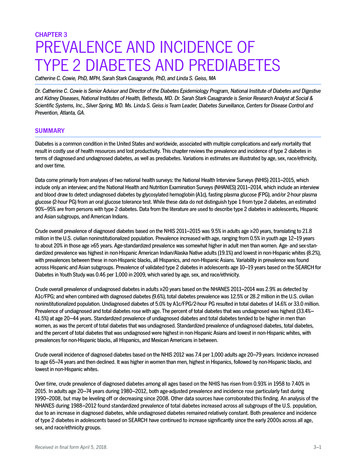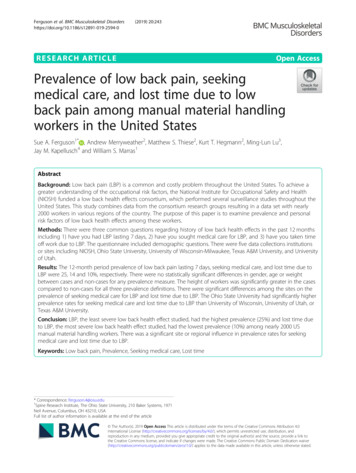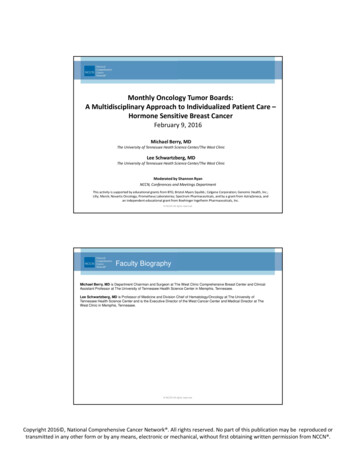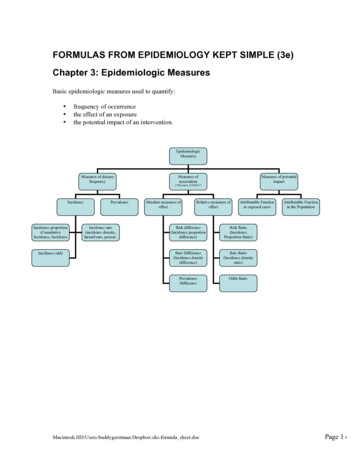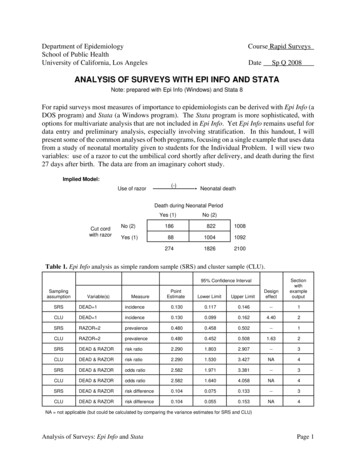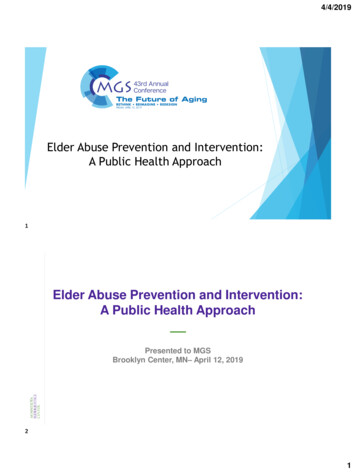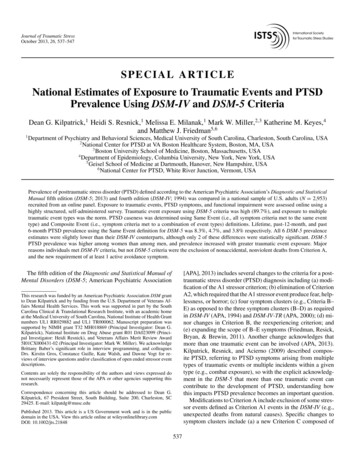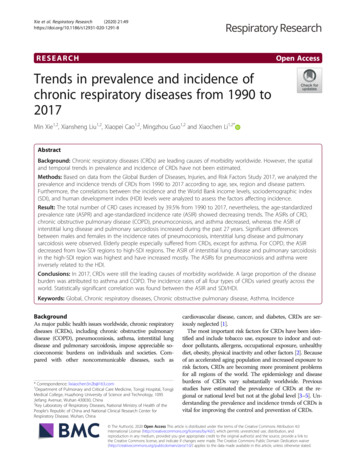
Transcription
Xie et al. Respiratory Research(2020) ARCHOpen AccessTrends in prevalence and incidence ofchronic respiratory diseases from 1990 to2017Min Xie1,2, Xiansheng Liu1,2, Xiaopei Cao1,2, Mingzhou Guo1,2 and Xiaochen Li1,2*AbstractBackground: Chronic respiratory diseases (CRDs) are leading causes of morbidity worldwide. However, the spatialand temporal trends in prevalence and incidence of CRDs have not been estimated.Methods: Based on data from the Global Burden of Diseases, Injuries, and Risk Factors Study 2017, we analyzed theprevalence and incidence trends of CRDs from 1990 to 2017 according to age, sex, region and disease pattern.Furthermore, the correlations between the incidence and the World Bank income levels, sociodemographic index(SDI), and human development index (HDI) levels were analyzed to assess the factors affecting incidence.Result: The total number of CRD cases increased by 39.5% from 1990 to 2017, nevertheless, the age-standardizedprevalence rate (ASPR) and age-standardized incidence rate (ASIR) showed decreasing trends. The ASIRs of CRD,chronic obstructive pulmonary disease (COPD), pneumoconiosis, and asthma decreased, whereas the ASIR ofinterstitial lung disease and pulmonary sarcoidosis increased during the past 27 years. Significant differencesbetween males and females in the incidence rates of pneumoconiosis, interstitial lung disease and pulmonarysarcoidosis were observed. Elderly people especially suffered from CRDs, except for asthma. For COPD, the ASIRdecreased from low-SDI regions to high-SDI regions. The ASIR of interstitial lung disease and pulmonary sarcoidosisin the high-SDI region was highest and have increased mostly. The ASIRs for pneumoconiosis and asthma wereinversely related to the HDI.Conclusions: In 2017, CRDs were still the leading causes of morbidity worldwide. A large proportion of the diseaseburden was attributed to asthma and COPD. The incidence rates of all four types of CRDs varied greatly across theworld. Statistically significant correlation was found between the ASIR and SDI/HDI.Keywords: Global, Chronic respiratory diseases, Chronic obstructive pulmonary disease, Asthma, IncidenceBackgroundAs major public health issues worldwide, chronic respiratorydiseases (CRDs), including chronic obstructive pulmonarydisease (COPD), pneumoconiosis, asthma, interstitial lungdisease and pulmonary sarcoidosis, impose appreciable socioeconomic burdens on individuals and societies. Compared with other noncommunicable diseases, such as* Correspondence: lixiaochen3n2b@163.com1Department of Pulmonary and Critical Care Medicine, Tongji Hospital, TongjiMedical College, Huazhong University of Science and Technology, 1095Jiefang Avenue, Wuhan 430030, China2Key Laboratory of Respiratory Diseases, National Ministry of Health of thePeople’s Republic of China and National Clinical Research Center forRespiratory Disease, Wuhan, Chinacardiovascular disease, cancer, and diabetes, CRDs are seriously neglected [1].The most important risk factors for CRDs have been identified and include tobacco use, exposure to indoor and outdoor pollutants, allergens, occupational exposure, unhealthydiet, obesity, physical inactivity and other factors [2]. Becauseof an accelerated aging population and increased exposure torisk factors, CRDs are becoming more prominent problemsfor all regions of the world. The epidemiology and diseaseburdens of CRDs vary substantially worldwide. Previousstudies have estimated the prevalence of CRDs at the regional or national level but not at the global level [3–5]. Understanding the prevalence and incidence trends of CRDs isvital for improving the control and prevention of CRDs. The Author(s). 2020 Open Access This article is distributed under the terms of the Creative Commons Attribution 4.0International License (http://creativecommons.org/licenses/by/4.0/), which permits unrestricted use, distribution, andreproduction in any medium, provided you give appropriate credit to the original author(s) and the source, provide a link tothe Creative Commons license, and indicate if changes were made. The Creative Commons Public Domain Dedication o/1.0/) applies to the data made available in this article, unless otherwise stated.
Xie et al. Respiratory Research(2020) 21:49The Global Burden of Diseases, Injuries, and Risk FactorsStudy (GBD) 2017 provided a comprehensive assessment ofburden of CRDs in 195 countries and territories [6]. Basedon this important data source, we assessed the spatial andtemporal trends in the prevalence and incidence of CRDsby age and sex from 1990 to 2017. It was estimated that theburden of chronic diseases, including CRDs, accounted for80% of the total burden in developing countries [7]. A negative association of socioeconomic status with the prevalencein COPD was revealed [8]. Asthma prevalence was foundto be highest in high-income regions [9]. Therefore, thePage 2 of 13correlations between the incidence and the World Bank income levels, sociodemographic index (SDI), and human development index (HDI) levels were analyzed to assess thefactors that affect incidence, and that is an important extension of previous research.MethodsData sourceThe prevalence, incidence, age-standardized prevalencerate (ASPR) and age-standardized incidence rates (ASIR)of CRD including COPD, pneumoconiosis, asthma andFig. 1 The age-standardized incidence rate (ASIR) and age-standardized prevalence rate (ASPR) of chronic respiratory diseases (CRDs) (a, b)including chronic obstructive pulmonary disease (COPD) (c), pneumoconiosis (d), asthma (e), and interstitial lung disease and pulmonarysarcoidosis (f) for both sexes (males and females). ASIR, age-standardized incidence rate; ASPR, age-standardized prevalence rate; COPD, chronicobstructive pulmonary disease
Xie et al. Respiratory ResearchFig. 2 (See legend on next page.)(2020) 21:49Page 3 of 13
Xie et al. Respiratory Research(2020) 21:49Page 4 of 13(See figure on previous page.)Fig. 2 The global incidence of chronic obstructive pulmonary disease (COPD) for both sexes in 195 countries and territories. a The agestandardized incidence rate (ASIR) of COPD for both sexes combined in 2017. b The relative percentage change in the ASIR of COPD for bothsexes between 1990 and 2017. c The estimated annual percentage change (EAPC) in the ASIR of COPD for both sexes from 1990 to 2017. COPD,chronic obstructive pulmonary disease; ASIR, age-standardized incidence rate; EAPC, estimated annual percentage changeinterstitial lung disease and pulmonary sarcoidosis, in 195countries and territories during 1990–2017 were obtainedfrom the GBD 2017 dataset (available online). The WorldBank classifies economies into four income groups: high,upper-middle, lower-middle and low. For the SDI, countries were classified as high-SDI regions, high-middle-SDIregions, middle-SDI regions, low-middle-SDI regions andlow-SDI regions. The HDI data were collected from theHuman Development Reports [10].Cases of COPD, pneumoconiosis (including asbestosis,coal workers’ pneumoconiosis, silicosis and other pneumoconiosis), asthma, interstitial lung disease and pulmonarysarcoidosis were identified based on the International Classification of Diseases and Injuries-10 diagnostic codes andare listed in Additional file 1: Table S1. It should be notedthat interstitial lung disease and pulmonary sarcoidosiscategory does not contain pneumoconiosis estimates in theGBD dataset.Statistical analysesThe standardized approach for estimating the sex- andage-specific prevalence and incidence from the GBD2017 dataset has been previously described [6, 11].Bayesian meta-regression with DisMod-MR 2.1 wasused as the main method of estimation for each condition. We generated 95% uncertainty intervals (UIs) forall data reported.The ASIR (cases per 100,000 population) and ASPR(cases per 100,000 population) from 1990 and 2017 wereanalyzed for each condition. The estimated annual percentage change (EAPC) of the ASIR was calculated using a generalized linear model with a Gaussian distribution [12].Fig. 3 The global incidence rate of chronic obstructive pulmonary disease (COPD) (a), pneumoconiosis (b), asthma (c) and interstitial lung diseaseand pulmonary sarcoidosis (d) by age and sex in 2017. Shading shows 95% uncertainty intervals. COPD, chronic obstructive pulmonary disease
Xie et al. Respiratory Research(2020) 21:49The relationships between the ASIRs and the WorldBank income levels, SDI, and HDI were assessed to explore the main factors influencing the incidence rates.The SDI and HDI were included as covariates for incidence, and the Spearman's rank-order correlation coefficients were used to measure the strength of thecorrelations between the ASIR and SDI, the ASIR andHDI, the EAPC of the ASIR and the change in the SDIbetween 1990 and 2017. The percentage change in SDIbetween 1990 and 2017 was calculated by the ratio ofthe SDI in 2017 to the SDI in 1990 for each country. AP value of less than 0.05 was regarded as statisticallysignificant.Page 5 of 132005 and subsequently increased from 2005 to 2017 in females, whereas showed a decreasing trend in males from2005 to 2017.Interestingly, the ASIR of CRDs in males were higherthan that in females until 2014, whereas the ASPR ofCRDs in females were higher than that in males, whichwas attributed to the higher prevalence rates of COPDand asthma in females.When analyzing each condition, an increase in theASIR of interstitial lung disease and pulmonary sarcoidosis was observed, while the ASIRs of COPD, pneumoconiosis, and asthma decreased from 1990 to 2017. Thelowest incidence rate of CRDs in 2005 was affected bythe incidence trend of asthma.ResultsChronic respiratory diseasesChronic obstructive pulmonary diseaseGlobally, the total number of CRD cases increased by39.5% from 389,713.8 (95% UI 362,943.0-416,351.4) thousand in 1990 to 544,899.2 (95% UI 506,937.5-584,858.4)thousand in 2017 (Additional file 2: Table S2). However,the ASIR decreased globally by an average of 0.33% (95%UI 0.17–0.48%) annually. Trends in the ASIR and ASPRof CRDs in both sexes are shown in Fig. 1. The ASIR decreased from 1990 to 2005 and subsequently increasedfrom 2005 to 2017. The ASPR decreased from 1990 toThe number of COPD cases increased by 49.8% from199,879.3 (95% UI 184,086.6-216,261.8) thousand in1990 to 299,398.1 (95% UI 269,025.2- 330,073.8) thousand in 2017 (Additional file 2: Table S2). The ASPR infemales was slightly higher than that in males in 1990and 2017.Figure 2 shows the ASIR of COPD for both sexes combined in 2017. This rate varied greatly from 90.0 (95% UI80.2–101.5) per 100,000 to 503.1 (95% UI 463.8–541.6)Fig. 4 The age-standardized incidence rate (ASIR) of chronic obstructive pulmonary disease (COPD) (a), pneumoconiosis (b), asthma (c) andinterstitial lung disease and pulmonary sarcoidosis (d) by sociodemographic index (SDI) regions from 1990 to 2017. COPD, chronic obstructivepulmonary disease; ASIR, age-standardized incidence rate; SDI, socio-demographic index
Xie et al. Respiratory Research(2020) 21:49per 100,000 across the world. The countries with the threehighest ASIRs were Papua New Guinea, North Korea andLesotho. The lowest ASIRs were reported in Cape Verde,Singapore and Japan (Fig. 2a).From 1990 to 2017, the ASIR decreased by an averageof 0.68% (95% UI 0.55–0.81%) in both sexes globally.Significant decreases in the ASIRs were observed in theMaldives (EAPC -2.52, 95% UI 2.64 to 2.40),Singapore (EAPC -1.94, 95% UI 2.15 to 1.70) andThailand (EAPC -1.91, 95% UI 2.02 to 1.79) (Fig.2c). The largest increases in the ASIRs were observed inArgentina (EAPC 1.32, 95% UI 1.14–1.50), Uruguay(EAPC 1.25, 95% UI 0.80–1.69) and Canada (EAPC 1.24, 95% UI 0.74–1.75).The global incidence rates of COPD in 1990 and 2017by age and sex are shown in Additional file 3: Figure S1and Fig. 3. COPD incidence increased with age, especiallyin those older than 90 years. The difference in the incidence rates between males and females was similar in1990 and 2017, with a male predominance after age 40.Page 6 of 13For SDI regions, the overall ASIR decreased fromlow-SDI regions to high-SDI regions. (Fig. 4). From1990 to 2017, the ASIR had a slightly increasingtrend in high-SDI regions (EAPC 0.21, 95% UI0.12–0.30) and declined gradually in the four otherSDI regions. The largest decline was noted in highmiddle-SDI regions (EAPC -1.17, 95% UI 1.36to 0.98). Similar decreasing ASIR trends were observed in low- and middle-income countries, and aslight increasing trend was observed in high-incomecountries according to World Bank income levels(Additional file 3: Figure S2). The ASIRs in high- andlow-income countries were lower than those inmiddle-income countries which is not synchronizedwith the trends of ASIR grouped by SDI regions.Neither the SDI nor HDI in 2017 were associated withthe ASIR of COPD (Additional file 5: Figure S3; Fig. 5).Meanwhile, no correlations between the EAPC in ASIRand the change in SDI during 1990–2017 were observed(Additional file 6: Figure S4).Fig. 5 The correlation between the human development index (HDI) and age-standardized incidence rate (ASIR) of chronic obstructivepulmonary disease (COPD) (a), pneumoconiosis (b), asthma (c) and interstitial lung disease and pulmonary sarcoidosis (d) in 2017. HDI, humandevelopment index; ASIR, age-standardized incidence rate; COPD, chronic obstructive pulmonary disease
Xie et al. Respiratory ResearchFig. 6 (See legend on next page.)(2020) 21:49Page 7 of 13
Xie et al. Respiratory Research(2020) 21:49Page 8 of 13(See figure on previous page.)Fig. 6 The global incidence of pneumoconiosis for both sexes in 195 conutries and territories. a The age-standardized incidence (ASIR) ofpneumoconiosis for both sexes combinded in 2017. b The relative percentage change in the ASIR of pneumoconiosis for both sexes between1990 and 2017. c The estimated annual percentage change (EAPC) in the ASIR of pneumoconiosis for both sexes from 1990 to 2017. ASIR, agestandardized incidence rate; EAPC, estimated annual percentage changePneumoconiosisAn increase of 81.1% in the number of pneumoconiosiscases were observed for both sexes from 1990 to 2017(Additional file 2: Table S2), whereas the ASPR decreased slightly. The ASPR in males was significantlyhigher than that in females during the study period. Globally, the ASIR of pneumoconiosis ranged from 0.006(95% UI 0.004–0.007) in Greece to 1.919 (95% UI1.714–2.142) per 100,000 in Taiwan (China) in 2017(Fig. 6a). New cases of pneumoconiosis increased by66.0% from 36.2 (95% UI 32.5–40.0) thousand to 60.1(95% UI 53.1–67.0) thousand from 1990 and 2017, witha downward trend in the ASIR (EAPC -0.57, 95% UI 0.53 to 0.61). The largest ASIR increases were observed in New Zealand (EAPC 2.61, 95% UI 2.55–2.67), Singapore (EAPC 1.31, 95% UI 1.08–1.55) andAustralia (EAPC 1.25, 95% UI 1.16–1.33). Countrieswith the most pronounced decreases were theNetherlands (EAPC -6.42, 95% UI 7.01 to 5.83),Belgium (EAPC -6.30, 95% UI 7.06 to 5.55) andPortugal (EAPC -5.51, 95% UI 6.22 to 4.79) (Fig.6c). For each type of pneumoconiosis, the global ASIRfor asbestosis showed an increasing trend (EAPC 0.57,95% UI 0.52–0.62) from 1990 to 2017, whereas the ASIRsfor silicosis (EAPC -0.77, 95% UI 0.85 to 0.70), coalworkers’ pneumoconiosis (EAPC -0.88, 95% UI 0.93 to 0.83), and other pneumoconiosis (EAPC -0.50,95% UI 0.54 to 0.46) showed decreasing trends.The incidence of pneumoconiosis increased with agein 1990 and 2017 (Additional file 3: Figure S1; Fig. 3).Significant sex difference was observed, and the incidence increased more among males than among femalesafter age 20.The ASIRs in high-SDI, low-middle-SDI, and low-SDIregions maintained low levels. The middle-SDI regionsshowed the highest ASIR and the greatest decrease overtime (EAPC -1.01, 95% UI 1.05 to 0.97), similar tothe ASIR trend for upper-middle income countries(Additional file 4: Figure S2). A negative correlation between ASIR and HDI in 2017 was observed (R -0.1673;P 0.0232) (Fig. 5).AsthmaThe number of asthma cases increased by 29.4% from210,684.3 (95% UI 186,332.0-236,730.0) thousand in1990 to 272,677.5 (95% UI 242,295.9-304,699.6) thousand in 2017 (Additional file 2: Table S2). In 2017, theASIR of asthma differed considerably across the world,ranging from 314.1 (95% UI 268.2–363.0) per 100,000 to1822.7 (95% UI 1484.7-2149.4) per 100,000. The threehighest ASIRs were observed in Tonga, Puerto Rico andAmerican Samoa, whereas the lowest ASIRs were observed in Italy, Spain, and Germany (Fig. 7a).Asthma accounted for 69.4% of the total CRDs incidence cases in 2017. New cases of asthma increased by19.0% from 1990 to 2017, although the ASIR remainedrelatively stable (EAPC -0.18, 95% UI 0.35 to 0.01).The highest ASIR increases were observed in the Solomon Islands (EAPC 1.29, 95% UI 1.14–1.44), Pakistan(EAPC 1.00, 95% UI 0.86–1.14) and Samoa (EAPC 0.98, 95% UI 0.89–1.07). The greatest ASIR decreaseswere observed in South Africa (EAPC -2.27, 95% UI 2.92 to 1.62), Guatemala (EAPC -1.42, 95% UI 1.57 to 1.28) and Honduras (EAPC -1.29, 95% UI 1.42 to 1.16) (Fig. 7c).In 1990 and 2017, the global incidence rate of asthmadecreased with age, especially in those younger than age10. However, the incidence slightly increased in peopleaged 65–74 (Additional file 3: Figure S1; Fig. 3). The incidence rates in males and females were similar.The temporal trends of the ASIRs in all five SDI regionsexhibited decreases until 2005, followed by subsequent increases, creating a u-shaped pattern. The ASIRs in highSDI and high-middle-SDI regions maintained low levels(Fig. 4), whereas the ASIR in low-income countries wasextremely high (Additional file 4: Figure S2). The ASIRwas found to be negatively related to the SDI (R -0.3167;P 0.0001) and HDI (R -0.3296; P 0.0001) in 2017(Additional file 4: Figure S3; Fig. 5). Furthermore, therewas an inverse correlation between the EAPC in the ASIRand the change of the SDI between 1990 and 2017 (R 0.1552; P 0.0303) (Additional file 6: Figure S4).Interstitial lung disease and pulmonary sarcoidosisThe number of interstitial lung disease and pulmonarysarcoidosis cases nearly doubled from 1990 to 2017(Additional file 2: Table S2), whereas the ASPRs in bothsexes slightly decreased.The ASIRs of interstitial lung disease and pulmonarysarcoidosis varied more than nine-fold, ranging from 2.19(95% UI 1.97–2.44) to 18.8 (95% UI 17.4–20.2) per 100,000, across the world in 2017. The highest rates were observed in Peru, Japan and Tajikistan and the lowest rateswere observed in Oman, Iraq and Sudan (Fig. 8a).Globally, the ASIR showed an increasing trend from1990 to 2017, with an EAPC of 0.41 (95% UI 0.36–0.46)
Xie et al. Respiratory ResearchFig. 7 (See legend on next page.)(2020) 21:49Page 9 of 13
Xie et al. Respiratory Research(2020) 21:49Page 10 of 13(See figure on previous page.)Fig. 7 The global incidence of asthma for both sexes in 195 conutries and territories. a The age-standardized incidence rate (ASIR) of asthma forboth sexes combinded in 2017. b The relative percentage change in the ASIR of asthma for both sexes between 1990 and 2017. c The estimatedannual percentage change (EAPC) in the ASIR of asthma for both sexes from 1990 to 2017. ASIR, age-standardized incidence rate; EAPC,estimated annual percentage change(Fig. 8c). The countries with the greatest increases wereGreece (EAPC 1.63, 95% UI 1.50–1.76), Ecuador(EAPC 1.56, 95% UI 1.49–1.64) and the United Kingdom (EAPC 1.48, 95% UI 1.45–1.52). The greatestASIR decreases were observed in Russia (EAPC -2.08,95% UI 2.25 to 1.92), Belarus (EAPC -1.60, 95% UI 1.74 to 1.46) and the Ukraine (EAPC -1.42, 95% UI 1.50 to 1.33).As shown in Additional file 3: Figure S1 and Additionalfile 5: Figure S3, the global incidence rates of interstitiallung disease and pulmonary sarcoidosis increased withage. The curves started to diverge after age 60, with the incidence increasing more in males than in females.For the SDI regions, a downward ASIR trend was observed in only high-middle-SDI regions (EAPC -0.35,95% UI 0.50 to 0.20), and the most significant increase was noted in high-SDI regions (EAPC 0.83, 95%UI 0.77–0.89). A similar trend of ASIR was observed inhigh-income countries (Additional file 4: Figure S2).DiscussionIn 2017, CRDs were still the leading causes of morbidityacross the world. A large proportion of the diseaseburden was attributed to asthma and COPD. From 1990to 2017, the new and total cases of CRDs increasedglobally, whereas the ASIRs and ASPRs experienceddecreasing trends, which may be explained by the population growth.COPD was the most prevalent CRD worldwide in2017, accounting for 54.9% of CRDs. The incidence rateof COPD increased with age in both sexes and decreasedin all age groups from 1990 to 2017, except for elderlypatients older than 80 years. At the national level, Japanranked among the top three countries with the lowestASIRs, whereas Papua New Guinea and North Koreahad the highest ASIRs in 2017. Large inequities inCOPD burden existed in different SDI regions. A significant decrease in the ASIR was observed in the highmiddle-SDI regions. The bulk of the burden of COPDstill occurred in the low-SDI regions.Pneumoconiosis is mainly attributed to occupationalrisk factors, and a minimum proportion of cases may becaused by the natural environment or second-handexposures [13]. Significant differences in incidencestratified by sex were observed for pneumoconiosis,which emerged as a male-predominant condition inpeople older than age 20. The sex-specific incidence ofpneumoconiosis has a correlation with sex-specificoccupational exposure. The temporal decline in the ASIRof pneumoconiosis was partly due to less occupational exposure. However, the ASIR for asbestosis showed an increasing trend, which might be partly explained by thelong latency period between asbestos exposure and themanifestation of the disease [14]. Pneumoconiosis remainsan important occupational health problem in developingcountries. In 2017, the highest ASIRs were noted in China,Papua New Guinea and North Korea. The countries classified as middle-SDI and upper-middle income had thehighest ASIRs and experienced significant decreases in theASIRs from 1990 to 2017.Asthma is a serious global health problem that affectsall age groups, especially children, as shown in Fig. 3.From 1990 to 2017, the global ASIR showed a decreasingtendency that turned into a slight increase. In our study,the global ASIR of asthma decreased with age. Accordingto the data from Human Development Reports, there wasa significant decline in the global population aged youngerthan 5 from 1990 to 2000. The number of people agedolder than 15 increased during 1990–2017. The young age(0–14) dependency ratio (per 100 people ages 15–64)showed a decreasing trend. On the other hand, the urbanpopulation of the world who have higher rates of asthmathan people in rural areas, have grown rapidly from 1990to 2017. Therefore, the U-shaped temporal ASIR trend forasthma might be a result of fertility decline, populationaging and urbanization. There was an inverse correlationbetween the ASIR and the SDI/HDI in 2017. Furthermore,the EAPC in ASIR was negatively related to the change ofthe SDI between 1990 and 2017, indicating that the incidence of asthma could be partly attributed to social andeconomic factors.Interstitial lung diseases are a group of diffuse parenchymal lung disorders [15] that are related to occupational orambient air pollution exposures [16]. Pulmonary sarcoidosis is an inflammatory lung disorder associated with ethnicity and latitude [17]. Notably, there was an increasingtrend in the global ASIR of interstitial lung diseases andpulmonary sarcoidosis from 1990 to 2017. The incidence inboth sexes presented a steep rise after age 60 in both 1990and 2017, and interstitial lung diseases and pulmonarysarcoidosis were much more prevalent in males than infemales, suggesting that older males are particularlyvulnerable. Although pulmonary sarcoidosis and lymphangioleiomyomatosis have a female predilection, [17] occupational exposure as a major cause of interstitial lung diseasewas more common in males than in females.
Xie et al. Respiratory ResearchFig. 8 (See legend on next page.)(2020) 21:49Page 11 of 13
Xie et al. Respiratory Research(2020) 21:49Page 12 of 13(See figure on previous page.)Fig. 8 The global incidence of interstitial lung disease and pulmonary sarcoidosis for both sexes in 195 conutries and territories. a The agestandardized incidence rate (ASIR) of interstitial lung disease and pulmonary sarcoidosis for both sexes combinded in 2017. b The relativepercentage change in the ASIR of interstitial lung disease and pulmonary sarcoidosis for both sexes between 1990 and 2017. c The estimatedannual percentage change (EAPC) in the ASIR of interstitial lung disease and pulmonary sarcoidosis for both sexes from 1990 to 2017. ASIR, agestandardized incidence rate; EAPC, estimated annual percentage changeAn age distribution analysis revealed that the incidenceof CRDs, except for asthma, increased with age and exhibited a strong increase in elderly people aged over 90 years.According to the World Health Organization, 2 billionpeople worldwide are expected to be 60 years or older by2050, accounting for 22% of the world’s population.Therefore, aging populations will become a profoundchallenge for CRD control and prevention.Tobacco use is an important risk factor for CRDs. Itwas estimated that the prevalence of tobacco use woulddecline by 25% for males and 42% for females from 1980to 2020, which may contribute to the decrease in the incidence of CRDs [18]. Sex and socioeconomic disparitiesin tobacco use have been identified. The cigarette smoking prevalence in males was more than four times higherthan that in females worldwide [19]. Globally, most of thecountries with the lowest prevalence of tobacco use werelow-income and middle-income countries, and the highestprevalence in both males and females was concentrated inEurope and the western Pacific [20]. However, a sex or socioeconomic status disparity was not noted for the prevalence of CRDs or COPD; this result might be explained byother risk factors, including indoor air pollution, ambientair pollutant exposure, occupational particulate exposure.A recent study revealed that the spatial heterogeneityof global particulate matter pollution significantly increased from 1998 to 2016. The most polluted areaswere concentrated in developing middle-income regions,such as northern India, the central Indo-China Peninsulaand southern and eastern China, which account for approximately 13.4% of the global land area and include56% of the world’s population [21]. The CRDs cases exposed to risk factors such as tobacco use and air pollution were not available in the GBD 2017 dataset, whichlimited the assessment of the influence of environmentalpollution on the prevalence of CRDs in this study.The relationships between the incidences and the SDI/HDI were assessed. Notably, the prevalence of misseddiagnoses of CRDs varied across all five SDI regions andcountries with different HDIs, [22–25] thus affecting theestimated incidences of reported CRDs. In addition, thenational epidemiologic survey on CRDs in many countries with large populations were not conducted in recent years, which may lead to an underestimation of thedisease burden. Therefore, the results of this study couldnot accurately reflect the actual correlation between theincidences and the SDI/HDI in the real world.ConclusionsThis study provided a global overview of CRDs in termsof prevalence and incidence and has important implications for further research and policy. From 1990 to 2017,the incidence rates of CRDs, COPD, pneumoconiosis,and asthma have decreased, whereas interstitial lung disease and pulmonary sarcoidosis showed an increasingtrend. Elderly people especially suffered from CRDs, except for asthma. Significant sex differences were observed in the ASIR of pneumoconiosis, interstitial lungdisease and pulmonary sarcoidosis. Large inequities inCOPD burden existed in different SDI regions. The bulkof the burden of COPD still occurred in the low-SDI regions. The ASIR of interstitial lung disease and pulmonary sarcoidosis in the high-SDI region was highest andhave increased mostly. The ASIRs for pneumoconiosisand asthma were inversely related to the HDI. The accelerated aging population and the increased exposureto risk factors including particulate matter pollution willincrease the global burden of CRDs. The findings emphasized the need to take public health actions to reverse this impending disaster.Supplementary informationSupplementary information accompanies this paper at al file 1: Table S1. International Classification of Diseases andInjuries-10 (ICD-10) diagnosis code.Additional file 2: Table S2. The global incidence, ASIR, prevalence andASPR due to chronic respiratory diseases in 1990 and 2017.Additional file 3: Figure S1. The global incidence rate of chronicobstructive pulmonary disease (COPD), pneumoconiosis, asthma andinterstitial lung disease and pulmonary sarcoidosis by age and sex in 1990.Additional file 4: Figure S2. The age-standardized incidence rate (ASIR)of chronic obstructive pulmonary disease (COPD), pneumoconiosis,asthma and interstitial lung disease and pulmonary sarcoidosis incountires classified by the World Bank income levels during 1990–2017.Additional file 5: Figure S3. The correlation between sociodemographic index (SDI) and age-standardized incidence rate (ASIR) ofchronic obstructive pulmonary disease (COPD), pneumoconiosis, asthmaand inters
from the GBD 2017 dataset (available online). The World Bank classifies economies into four income groups: high, upper-middle, lower-middle and low. For the SDI, coun-tries were classified as high-SDI regions, high-middle-SDI regions, middle-SDI regions, low-middle-SDI regions and low-SDI regions. The HDI data were collected from the


